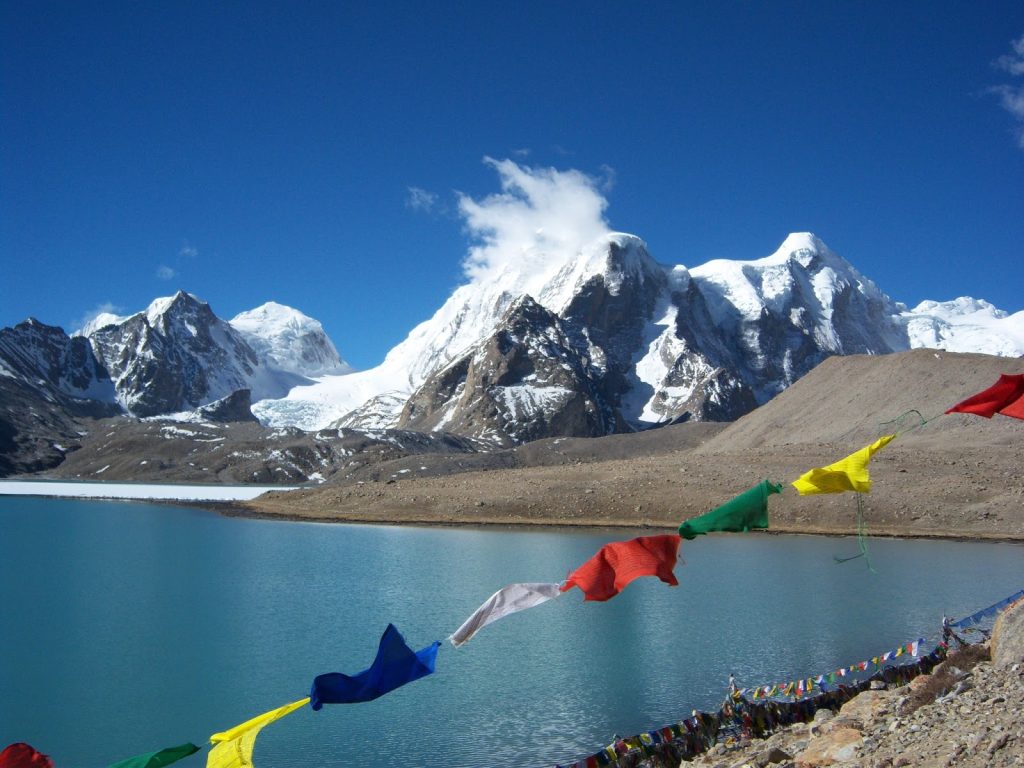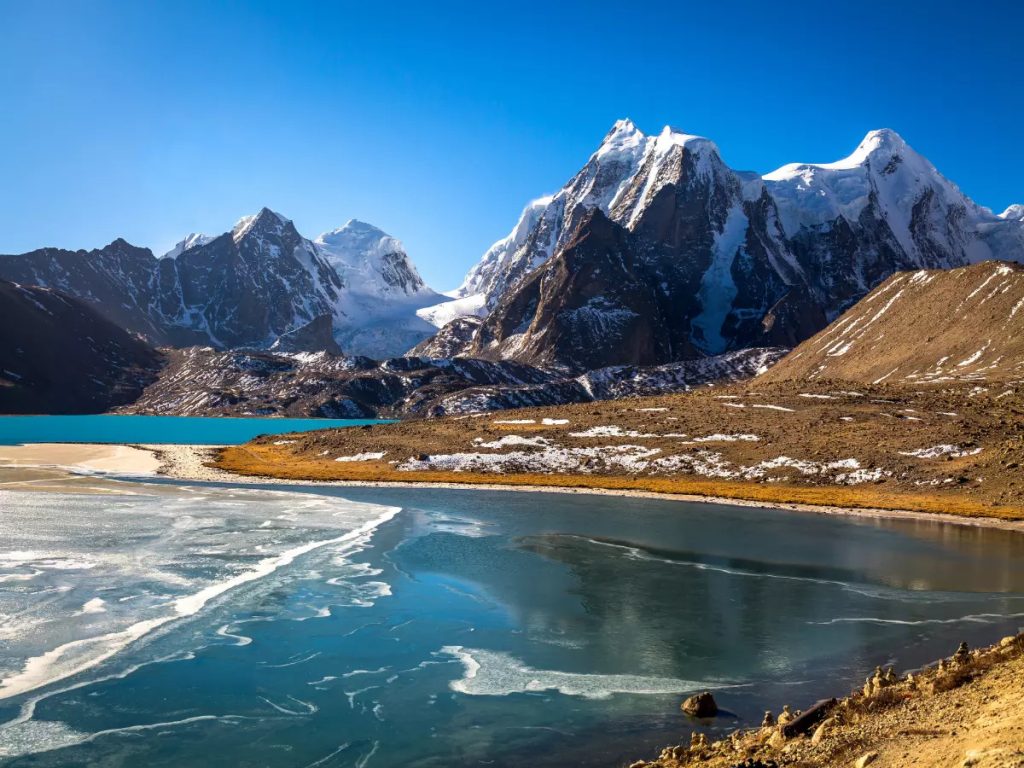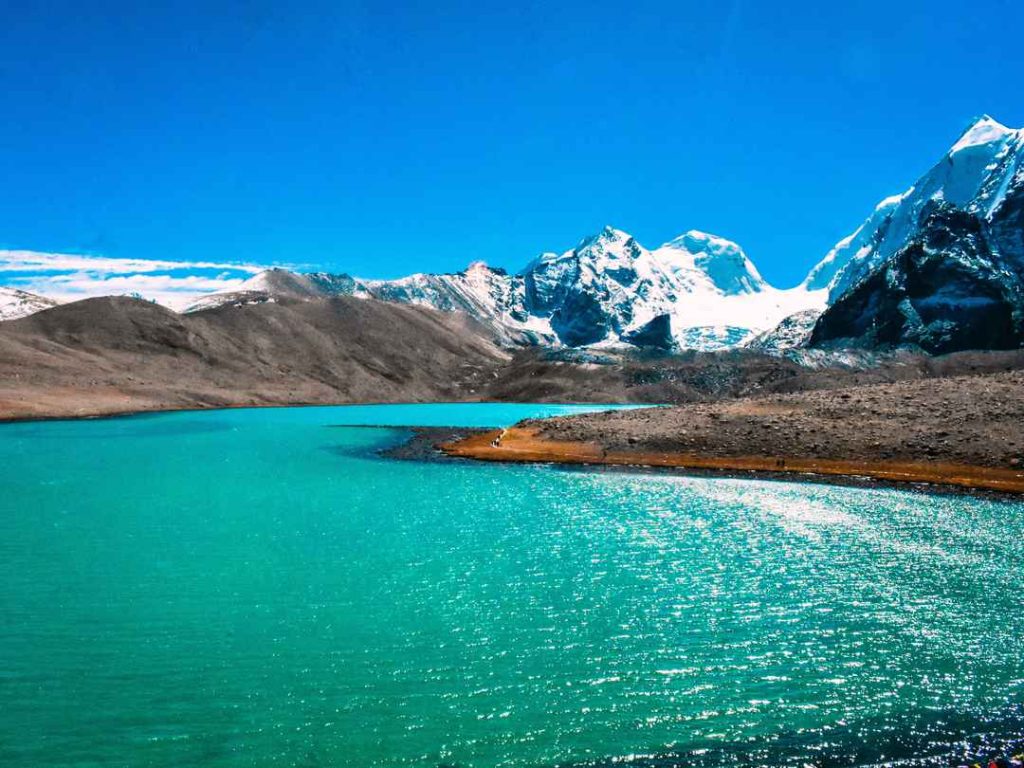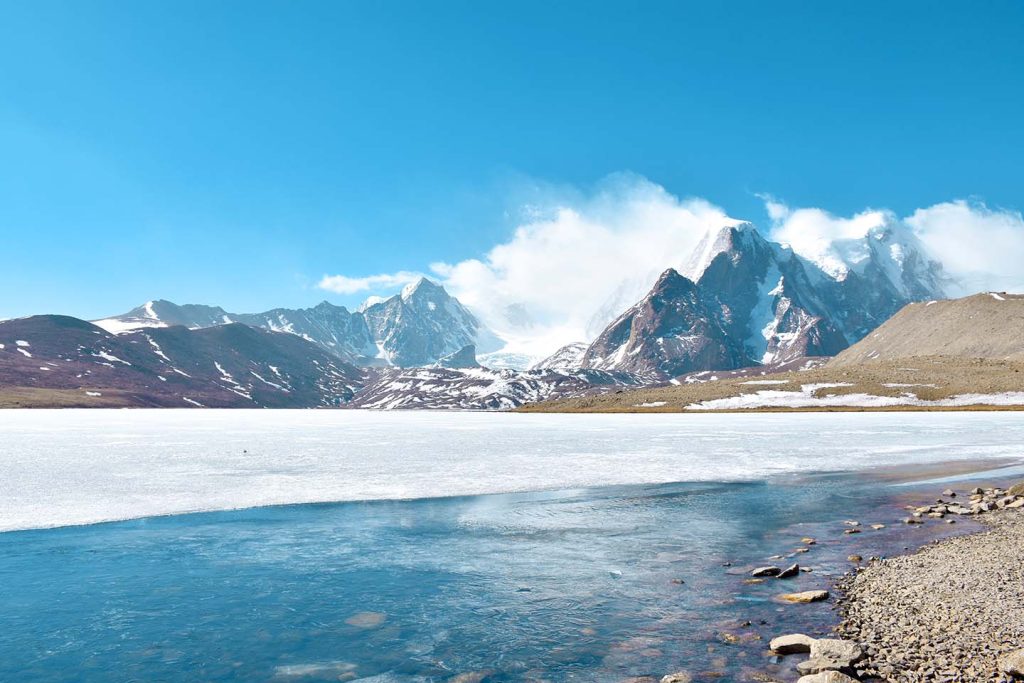Gurudongmar Lake, also known as Gurudogmar Lake, is one of the highest lakes in the world, located at an altitude of 17,800 ft (5,430 m) in the Indian state of Sikkim. It is a lake which is considered sacred by Buddhists. The lake is named after Guru Padmasambhava, also known as Guru Rinpoche, founder of Tibetan Buddhism who visited the lake in the 8th century. As per Denjong Nye-Yig (The Pilgrim’s Guide to The Hidden Land of Sikkim, by Jigme Pawo, reincarnation of Gyalwa Lhatsun Chenpo) and Nay-Sol texts, Gurudongmar Lake, located at an altitude of about 17,000 feet within the Lachen Dzomsa area in North District, Sikkim, is one of the 108 “Tso-Chen” or major holy lakes of Denjong (Sikkim) which are believed to be abodes of local guardian deities. The holy lake is located close to Mt. Khangchen Gyao, also considered sacred by the locals. During the eight century AD, Guru Padmasambhava, also referred to by Buddhists as Guru Rinpoche, hailing from the Swat region in present-day northwest Pakistan, visited Tibet at the invitation of Chogyal (Tibetan emperor) Trisong Deutsen, and introduced the practice of Tantric Buddhism to the Tibetans. On his way back from Tibet, Guru Rinpoche is believed to have visited Sikkim and Gurudongmar Lake was probably the first major landmark that the Guru came across upon his entry into the fabled hidden land of “Denjong”/”Demojong”. The word “Dongmar Shab Chakpa” refers to his visit to this place. He recognised the lake as a part of Dorje Nyima/Chorten Nyima, a sacred place of worship in northern Sikkim. It is believed that the Guru, in order to provide drinking water to the local people during winter when the lake freezes, placed his hands on a part of the lake, which miraculously stopped freezing during winter, thereby facilitating in provision of drinking water to the locals. Since then, the water of the lake is considered sacred. Recognising the auspicious omens in the lake, Guru Rinpoche saw them as propitious and favourable signs welcoming his entry into the land of Denjong/Demojong. Devotees believe that by offering prayers at the holy lake, one can be blessed with the birth of a child/children. The lake is not only blessed by Guru Padmasambava but also by Guru Nanak, the spiritual leader of Sikhism while he had passed through this area, and hence regarded as sacred. The high altitude lake which remains frozen during winter months is located in the region of northern Sikkim, in the district of North Sikkim. It is about 5 kilometres (3.1 mi) to the south of the Chinese border. The lake can be reached by road from Lachen via Thangu. It is 190 kilometres (120 mi) away from Gangtok, the capital city of Sikkim. The approach road from Thangu to Gurudongmar passes through a rugged and enchanting terrain with “stony moraine”, which has high alpine pastures covered with many rhododendron trees. While Indian tourists are allowed to visit the lake, foreigners need to get a special permit from the Ministry of Home Affairs in Delhi. A legend related to the frozen condition of the lake is linked to the visit of Guru Padmasambhava to the lake, on his way back from Tibet. When he saw the lake he felt that the lake was worthy of veneration as it represented the divine location of Dorje Nyima or Chhoedten Nyima. As the lake remained frozen most of the year with no possibility of providing for drinking water needs, the people of the area appealed to Padmasambhva to help them. Then the guru agreed to help them and placed his hands on a small part of the lake area which stopped freezing during winter thus facilitating the source of drinking water to the people. Since then the lake has been considered sacred and devotees carry this sacred water in containers. According to another legend when Padmasambhava visited the lake he saw an auspicious phenomenon in the lake and then he considered it a good augury to enter the mainland of Sikkim, then known as Demojong. It is now said that the lake grants a boon to any pregnant woman offering prayers at the lake. The lake fed by glaciers is located to the north of the Kanchenjunga range in a high plateau area connected with the Tibetan Plateau. The lake provides one of the source streams which joins the Tso Lahmu and then form the source of Teesta River. China is 5 km (3.1 mi) to the border on the east. The lake remains completely frozen in the winter months from November to Mid-May. The lake has an area of 118 hectares (290 acres) and its peripheral length is 5.34 kilometres (3.32 mi). However, the size of the lake appears small at the place where the devotees offer worship but the larger part of the lake is not visible due to hilly topography obstructing the complete view at this location. The area surrounding the lake, also known as Gurudongmar, is inhabited by Yaks, blue sheep and other wildlife of high altitude. This fresh-water lake, which once used to have very clear water, with even the bed of the lake being visible from the surface, now appears in white colour on account of local pollution. A dispute arose when on the bank of the lake an Indian Army regiment of the Sikhs located at the Indo-China border, considering the lake as the place visited by their saint Guru Nanak, constructed a Gurudwara in 1997–98. This created anger among the Sikkimese people of the area as they considered the Gurudwara as an illegal construction as their ancient sacred lake had been sanctified by the visit of their Guru Padmasambhava. The government of Sikkim then constituted a high level committee to examine the issue and submit a report. Documents furnished to the committee by the Namgyal Institute of Tibetology, Gangtok conclusively established the authentic claim of the local people that it was with out doubt a Buddhist religious place. This was accepted by the committee. The building constructed by the Sikh regiment was then handed over by the army to the Lachen Monastery on 6 July 2001 in the presence of the Sub Divisional Magistrate, Chungthang, North Sikkim. Now the monastery has placed a lama as a watchman at the lake, entrusted with the task of maintenance of the lake. At the time of the dispute, the president of the Shiromani Gurudwara Prabhandak Committee (SGPC) had requested the Defense Minister of India to intervene and stop the demolition of this Gurudwara as it was linked to the visit of Guru Nanak.
Gallery




